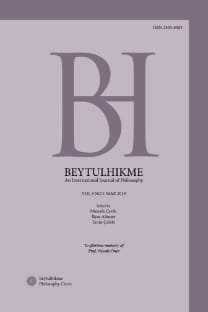Spiritual foundation of the Asian civilizations: The unity of verity, Beauty and Divinity in buddha and rūmī
Çok çeşitli Asya halklarını ve ülkelerini Asya toplumu kavramı altında birleştiren şey nedir? Belli din, kültür, dil, ırk ayrımına karşın, varlığımızın derinliğinden fışkıran ruhsal bir şeyin bizi gerçek toplumun açık görüşünü paylaşmaya götürdüğünü hissedebiliriz. Eğer akademik çabalarımız bu varlık ayrımında Asya toplumunun öz kimliğini bulmayı başarırsa, çoğulluk ve çeşitlilik yaşamın yaratıcılık ve zenginliğinin kutlu anlamına sahip olacaktır. Doğal olarak, bu uyanış dünya toplumu için medeniyetler ittifakı anlamına gelecektir. Asya toplumunun bu öz kimliğini tanımlama işi, Asya medeniyetleri arasındaki gizli bağlara dair tarihsel ve arkeolojik kazılarla yakından ilgilidir. Ruhsal bağ, toplumun anlamlandırılması ve bu çeşitli sosyal ve kültürel bağlara yöneltilmesi konusunda öneme sahiptir. Asya medeniyetlerinin ortak ruhsal temeli hakkındaki çalışmamız, Asyanın gerçekliği aydınlatan sabah diyarı olduğunu açıklığa kavuşturacaktır.
Asya medeniyetlerinin ruhsal temeli: Buda ve Rûmîde gerçeklik, güzellik ve kutsallığın birliği
What makes so many diverse Asian peoples and countries sympathize with the notion of the Asian Community? In spite of the apparent difference of religion, culture, language, race; we can feel that something spiritual emanating from the bottom of our Being leads us to share the open mind of the true community. If our academic efforts succeed to find self-identity of the Asian Community in this dimension of the Being, the plurality and diversity will have the celebrating meaning of creativity and richness of Life. Naturally, this awakening will imply the alliance of civilizations for the World community. This work of defining self-identity of the Asian Community is closely related to the historical and archaeological excavations of the hidden links between the Asian civilizations. The spiritual link has the significance of giving the meaning and direction of the community to these various social and cultural links. Our study on the common spiritual foundation of the Asian civilizations will make it clear that Asia is the morning land illuminating the verity.
___
- Bergson, H. (1990). Matière et Mémoire: Essai sur la Relation du Corps à lEsprit. Lille: Édition Électronique par Gemma Paquet.
- Bergson, H. (1907). Lévolution Créatrice. Lille: Édition Électronique par Gemma Paquet.
- Bergson, H. (1932). Les Deux Sources de la Morale et de la Religion. Lille: Édition Électronique par Gemma Paquet.
- Czaplicka, M.A. (2007). Shamanism in Siberia Aboriginal Siberia, A Study in Social Anthropology. Forgotten Books.
- Eliade, M. (1989). Histoire des Croyances et des Idées Religieuses. Paris: Payot.
- Heidegger, M. (1972). Sein und Zeit. Tübingen: Max Niemeyer Verlag.
- Heidegger, M. (1976). Brief über den Humanismus. Wegmarken. Frankfurt am Main: Vittorio Klostermann.
- Heidegger, M. (1977). Der Spruch des Anaximander. Holzwege. Frankfurt am Main: Vittorio Klostermann.
- Kuhn, T. (1962). The Structure of Scientific Revolutions. Chicago: The University of Chicago Press.
- Lyotard, J.-F. (1979). La Condition Postmoderne. Paris: Les Édition de Minuits.
- Maritain, J. (1953). Creative Intuition in Art and Poetry. New York: Pantheon Books.
- Rūmī, M.J. (1925-40) The Mathnawí of Jaláluddin Rúmí (trans. R.A. Nicholson). Cambridge: Cambridge University Press.
- Merton, T. (1948). The Seven Storey Mountain. New York: Harcourt Brace.
- Murti, T.R.V. (1958). The Central Philosophy of Buddhism-A Study of the Madhyamika System. London: George Allen & Unwin.
- Popper, K. (1945). The Open Society and Its Enemies. London: G. Routledge & Sons.
- The Prajna Paramita Hridaya Sutra (2000). (trans. L. To). New York: Sutra Translation Commitee.
- Woo-Won, C. (2006). Towards a New Dimension of Existence. The Rise of Asian Community and the New Dialogue between Past and Future of the World.
- Proceedings of the Second International Conference of the Asian Philosophical Association. Pusan: Dae Dong Philosophical Association.
- Woo-Won, C. (2008). Epistemology for a Harmonized World Order. Ideals of the Asian Community: Aspirations for a Harmonized World Order. Proceedings of the Third International Conference of the Asian Philosophical Association. Istanbul: Fatih University Press.
- ISSN: 1303-8303
- Başlangıç: 2011
- Yayıncı: Mustafa Çevik
Sayıdaki Diğer Makaleler
Hürriyet problemi bağlamında insan fillerindeki temel dinamiklerin farabi felsefesindeki yeri
Dil, anlamlandırma ve yorumlama üzerine bir deneme
Spinoza'nın teolojik-politik inceleme'sinin felsefî ve teolojik bağlamda okunuşu üzerine
Toplumsal paradigmanın felsefî düşünüşe etkisi: Stoa ve kant örneği
Spinoza'nın teolojik-politik inceleme'sinin felsefî ve teolojik bağlamda okunuşu üzerine
